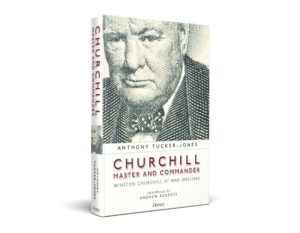Finest Hour 162
Books, Arts & Curiosities – The Debate in the Air

Winston Churchill, Parliament Square, London © Sue Lowry & Magellan PR
February 19, 2015
Finest Hour 162, Spring 2014
Page 50
By Christopher M. Bell
Churchill and his Airmen: Relationships, Intrigue and Policy Making 1914-1945, by Vincent Orange. Grub Street Publishing, 320 pages, $49.99, Kindle edition $10.98, member price $39.95.
Churchill’s relationships with the uniformed leaders of Britain’s three fighting services have always been controversial, although his frequent clashes with generals and admirals have tended to attract more attention than his periodic scrapes with airmen. The air marshals were certainly not exempt from Churchill’s displeasure, as shown here by Vincent Orange, a prolific writer on the Royal Air Force and biographer of leading air marshals. But smoother relations have not always meant less controversy.

2025 International Churchill Conference
It is now widely accepted that Churchill tended to interfere too much with his professional advisers in wartime, but he is also sometimes criticised for not interfering enough—and especially for giving some of his airmen, most notably Hugh Trenchard and Arthur “Bomber” Harris, a relatively free hand. For many critics of Churchill’s leadership in the Second World War, his support for the Royal Air Force in general and the strategic bombing campaign in particular was a serious miscalculation.
Churchill’s confidence in the Royal Air Force, though sometimes misplaced, is not difficult to understand. Orange shows that Churchill was always “air-minded.” As First Lord of the Admiralty in 1911-15 he became the darling of the British aviation press by enthusiastically fostering the development of the Royal Navy’s new air service. During World War I, Churchill was eager to use Britain’s air resources offensively, and produced a stream of creative schemes for striking the Germans from the skies. He never doubted that these new weapons were indispensable for the Allied war effort, and as Minister of Munitions in 1917-18 he made their construction one of his top priorities.
His greatest service to the RAF, however, almost certainly came after the fighting had stopped. As Secretary of State for Air in 1919-21, Churchill was instrumental in ensuring that the new air service, which had only been established as an independent entity in 1918, was not abolished and its assets divided between the two older services, which were naturally eager to regain control over their air resources.
Churchill’s intervention on behalf of the RAF stemmed from a conviction that an independent air force offered the best means to ensure that Britain would stay at the forefront of developments in military aviation. It would be a mistake, he warned, for the new arm to be held “in perpetual thraldom to the army or the navy.” In time, he expected aircraft to take over many of the duties traditionally performed by soldiers or warships. While still serving as Air Minister, Churchill achieved large economies by substituting the Royal Air Force for army units to preserve order in Iraq. A few years later, as Chancellor of the Exchequer, he believed that additional savings could be achieved by relying more heavily on aircraft than heavy guns for the defence of Singapore.
Churchill remained a strong sup- porter of the RAF during the Second World War, and repeatedly threw his weight behind the strategic bombing campaign against Germany in 1942- 43, even though Britain’s heavy commitment to this offensive reduced the number of squadrons available to support operations by the army and navy. But Churchill did not subscribe to the extreme view of some airmen that bombing alone would defeat Germany. Orange is rightly critical of Harris and Portal for overstating their claims for Bomber Command, although he does not probe their relationship with Churchill at great length. Only one of the twenty-three chapters is devoted to the strategic air campaign, rather inadequate for such an important and controversial topic.
The author provides extensive coverage of operations in other theatres, such as the Mediterranean and Normandy, but these accounts are something of a mixed bag. They undoubtedly showcase Orange’s strengths as a biographer, offering a readable and at times insightful account of Britain’s leading airmen, many of whom he has written about already. Most readers will find these chapters entertaining and informative, although they will also discover that there is little said about Churchill, who did not interfere with airmen in operational theatres to nearly the same extent as he did with generals or admirals. Consequently, the campaigns Orange seems most interested in chronicling are ones where Churchill had little direct contact with the airmen in charge. By the book’s final chapters, Churchill disappears from the text for pages at a time.
In the end, Orange offers a mixed verdict on Churchill’s record as war leader, one based largely on his ability to back the “right” airmen. The outstanding air commanders during the war, in Orange’s opinion, were Hugh Dowding, architect of victory in the Battle of Britain, and Arthur Tedder, who distinguished himself in the Mediterranean theatre and later as Eisenhower’s deputy commander for Overlord. Fortunately, Churchill backed these men when it mattered most, demonstrating that, contrary to popular wisdom, he was capable of remaining in the background and allowing competent commanders to do their jobs.
Dr. Bell is a professor of history at Dalhousie University, and author of Churchill and Sea Power.
Subscribe
WANT MORE?
Get the Churchill Bulletin delivered to your inbox once a month.






